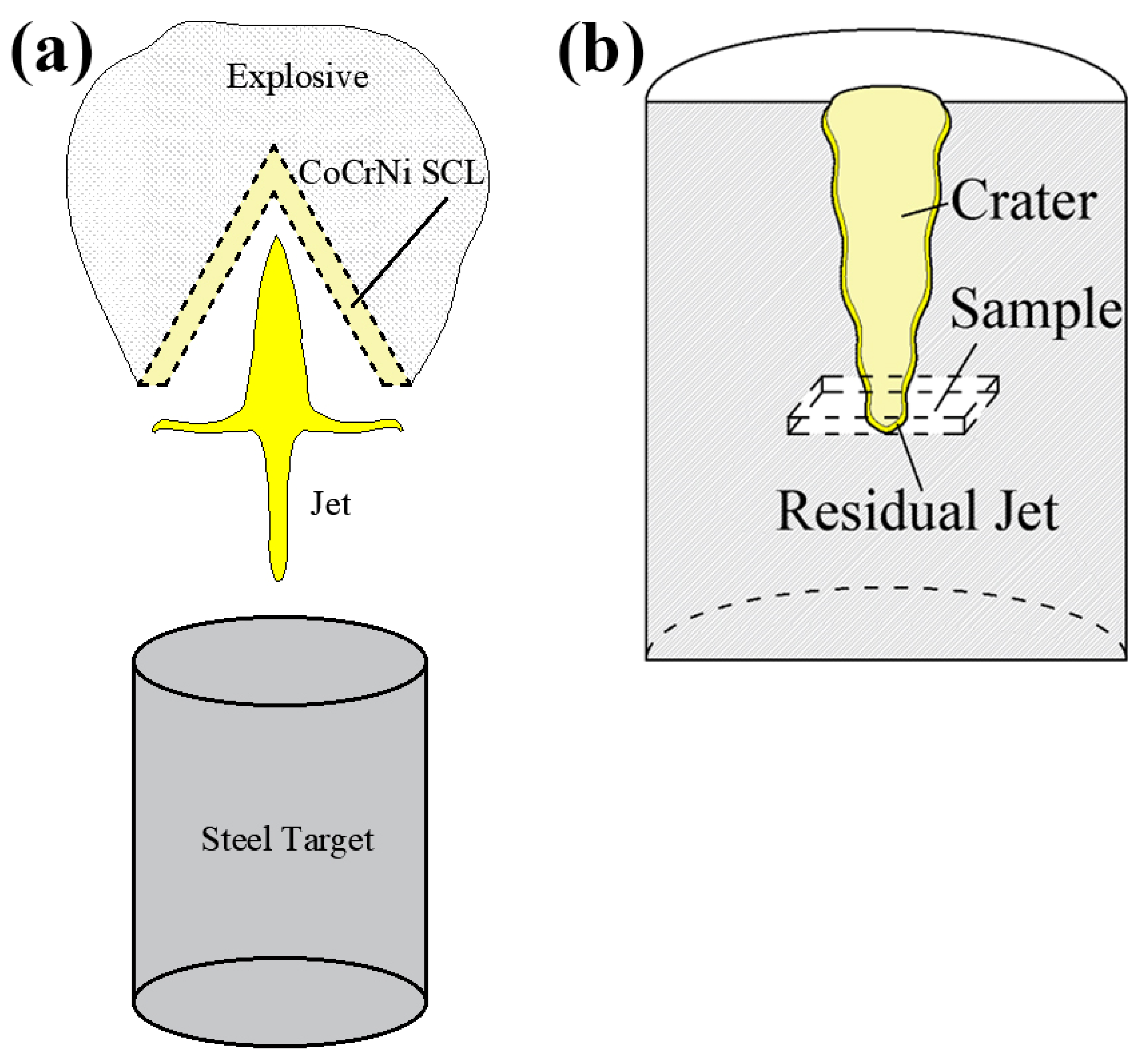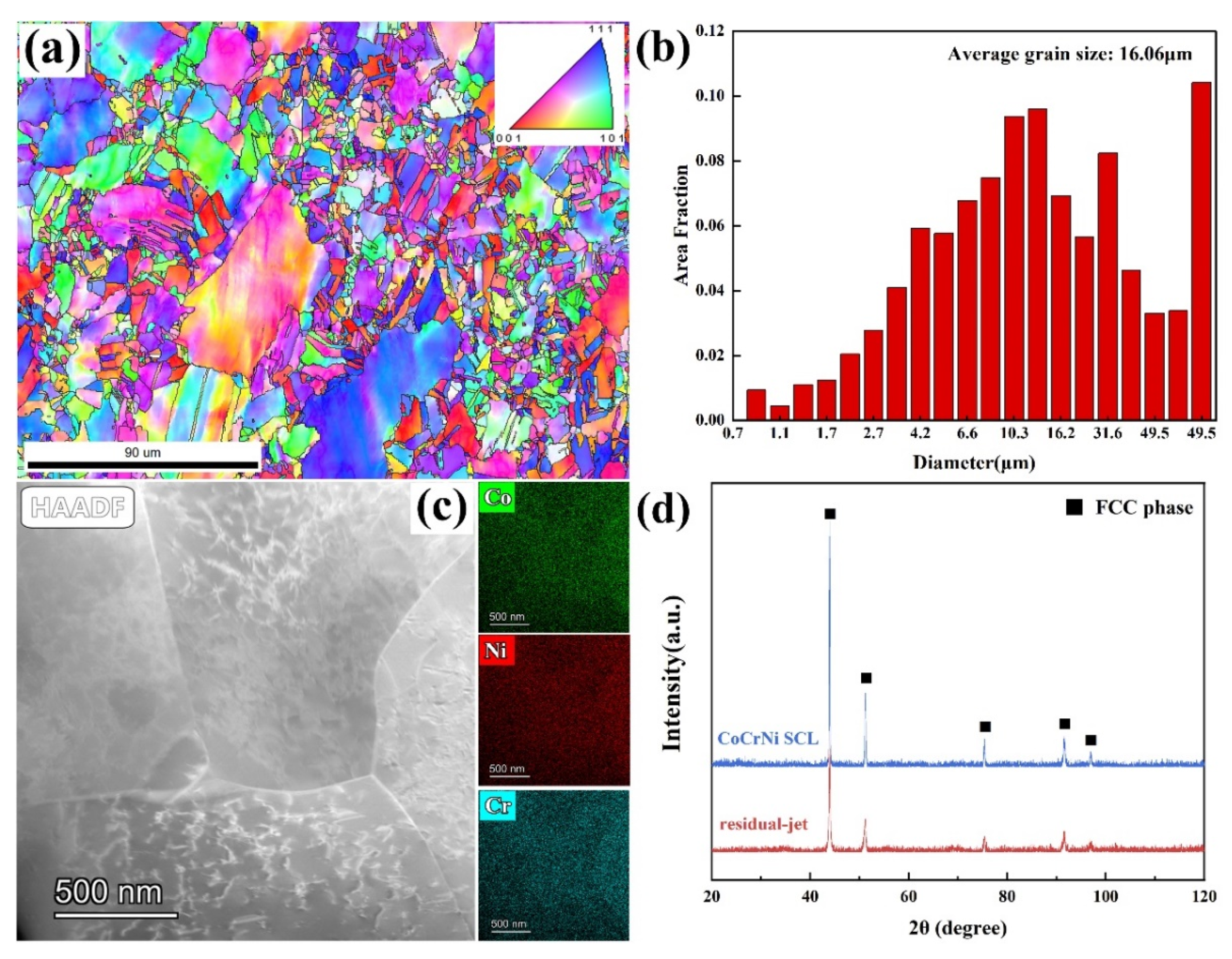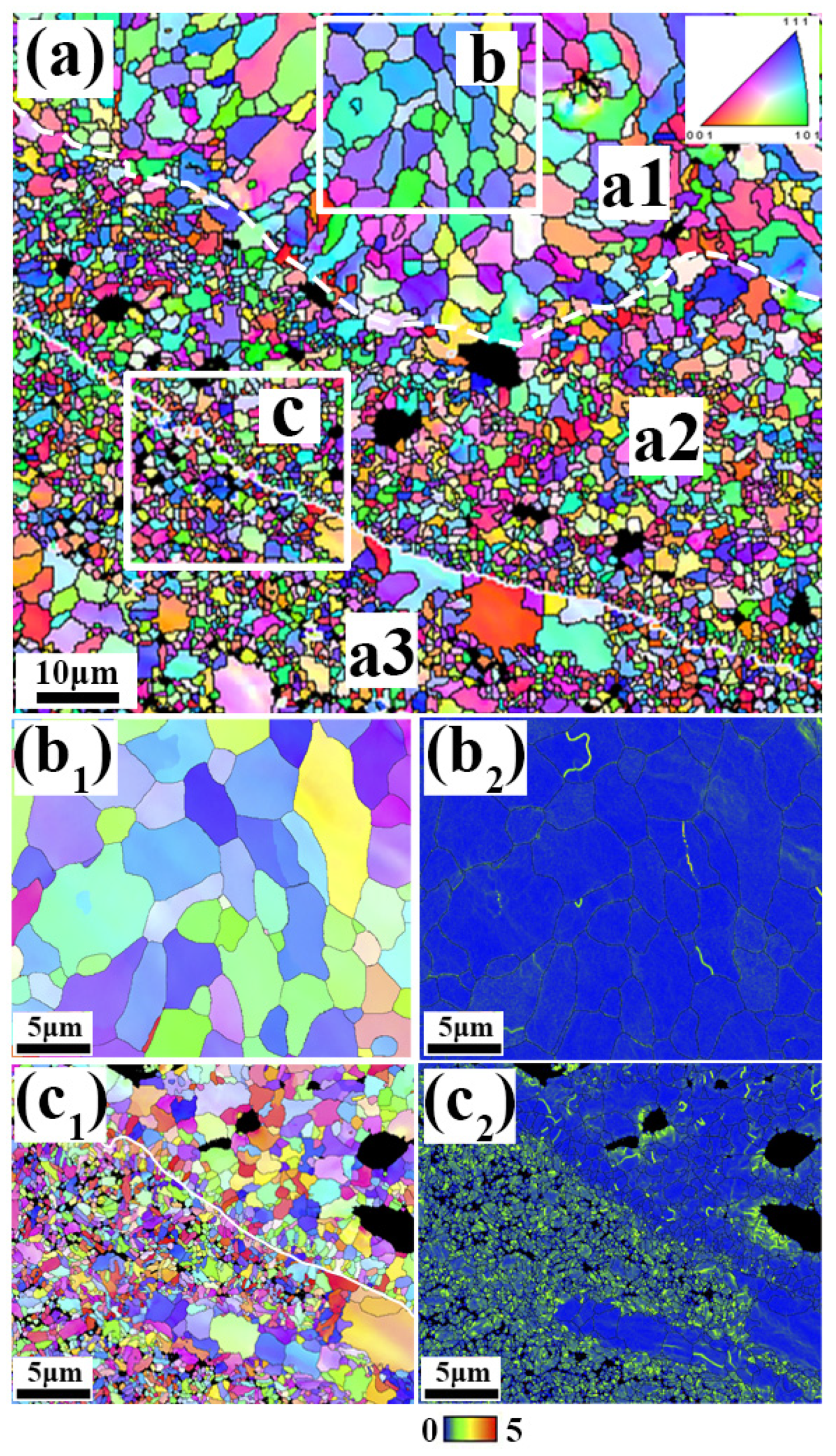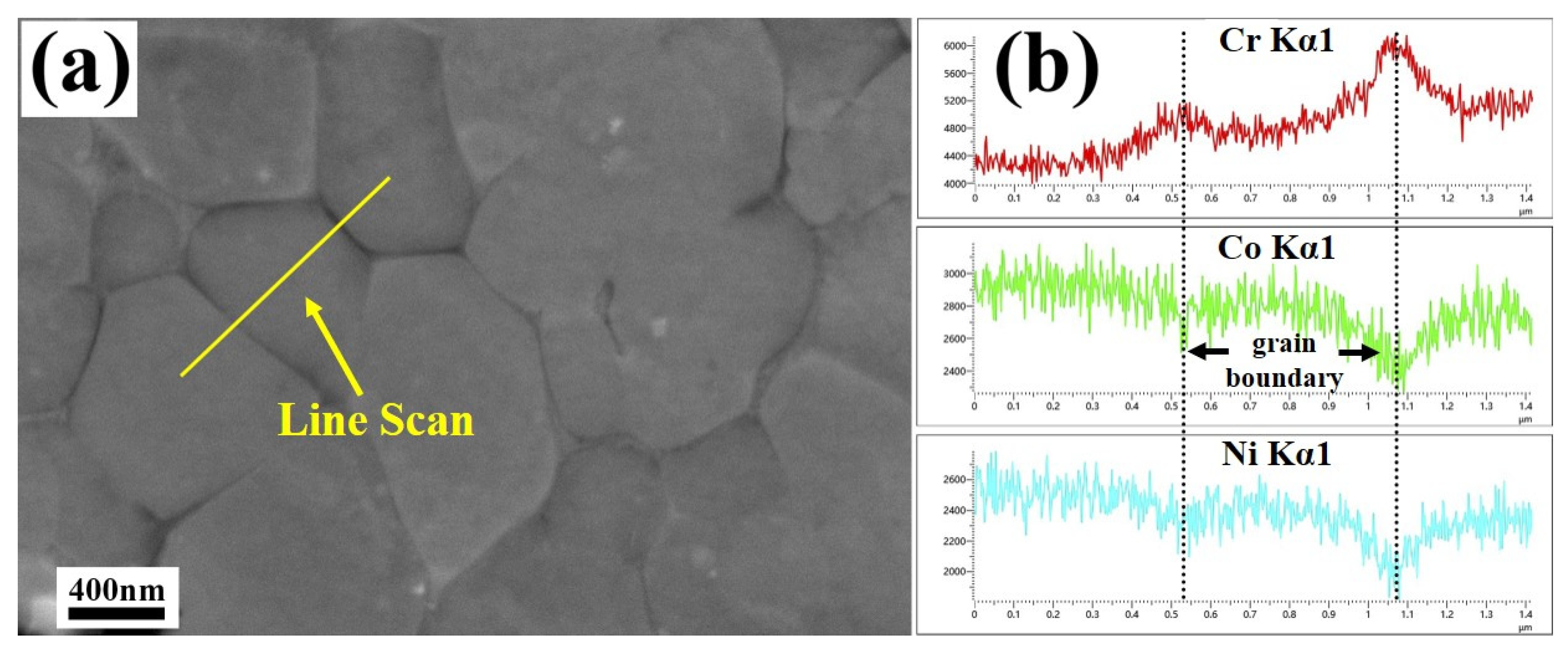Deformation Behavior and Microstructure Evolution of CoCrNi Medium-Entropy Alloy Shaped Charge Liners
Abstract
:1. Introduction
2. Materials and Methods
2.1. Preparation of the CoCrNi SCL
2.2. Explosive Detonation
2.3. Microstructure Characterization
3. Results
3.1. Initial Microstructures of CoCrNi SCL
3.2. Microstructures in the Residual Jet
3.3. Grain Boundary Precipitations
4. Discussion
4.1. Dynamic Recrystallization in CoCrNi Shaped Charge Detonation
4.2. Cr-Rich Grain Boundary Precipitation
5. Conclusions
- The CoCrNi SCL experienced a severe grain size reduction from 16 μm to less than 5 μm during penetration. After penetration, the residual jet was composed of equiaxed grains in the recrystallization zone and elongated grains within the deformation zone. Dislocations were few and were distributed uniformly in residual jet.
- An obvious dynamic recrystallization phenomenon was observed in residual jet, which led to a severe grain size reduction. The refined grain structures are supposed to accommodate the large strains in the severe plastic deformation of the shaped charge jet.
- Compared to the initial SCL, the content of Cr at the grain boundaries in the residual jet increased significantly, while the content of Co and Ni decreased. Furthermore, the nanosized Cr-rich precipitates with BCC structures were observed to be widely distributed along grain boundaries. The reduced grain size reduced the bulk diffusion path of Cr from grain interior to the grain boundary. The Cr-rich precipitations were considered obstacles for grain boundary movement and promotion of crack initiation along the grain boundaries, which depleted the ductility of the CoCrNi-shaped charge jet and its ability to penetrate.
Author Contributions
Funding
Data Availability Statement
Conflicts of Interest
References
- Jiao, W.; Chen, X. Review on Long-Rod Penetration at Hypervelocity. Adv. Mech. 2019, 49, 312–391. [Google Scholar] [CrossRef]
- Meyers, M.A. Dynamic Behavior of Materials; Wiley: Hoboken, NJ, USA, 1994; ISBN 9780471582625. [Google Scholar]
- Li, G.; Chen, X.W. Selection and Analysis of Material Models in Copper Jet Penetration into Water. J. Phys. Conf. Ser. 2020, 1507, 032017. [Google Scholar] [CrossRef]
- Murr, L.E.; Niou, C.S.; Garcia, E.P.; Ferreyra, E.T.; Rivas, J.M.; Sanchez, J.C. Comparison of Jetting-Related Microstructures Associated with Hypervelocity Impact Crater Formation in Copper Targets and Copper Shaped Charges. Mater. Sci. Eng. A 1997, 222, 118–132. [Google Scholar] [CrossRef]
- Song, P.; Li, W.B.; Zheng, Y.; Song, J.P.; Jiang, X.C.; Yan, B.Y. Study on Plastic Deformation Behavior of Mo-10ta under Ultra-High Strain Rate. Metals 2020, 10, 1153. [Google Scholar] [CrossRef]
- Meyers, M.A.; Meyer, L.W.; Vecchio, K.S.; Andrade, U. High Strain, High Strain-Rate Deformation of Copper. J. Phys. IV Proc. 1991, 1, C3-11–C3-17. [Google Scholar] [CrossRef]
- Chokshi, A.H.; Meyers, M.A. The Prospects for Superplasticity at High Strain Rates: Preliminary Considerations and an Example. Scr. Metall. Mater. 1990, 24, 605–610. [Google Scholar] [CrossRef]
- Shih, H.K.; Murr, L.E.; Niou, C.S.; Zernow, L. Dynamic Recrystallization in a Tantalum Shaped Charge. Scr. Metall. Mater. 1993, 20, 1–8. [Google Scholar]
- Murr, L.E.; Niou, C.S.; Sanchez, J.C.; Shih, H.K.; Duplessis, L.; Pappu, S.; Zernow, L. Comparison of Beginning and Ending Microstructures in Metal Shaped Charges as a Means to Explore Mechanisms for Plastic Deformation at High Rates. J. Mater. Sci. 1995, 30, 2747–2758. [Google Scholar] [CrossRef]
- Andrade, U.; Meyers, M.A.; Vecchio, K.S.; Chokshi, A.H. Dynamic Recrystallization in High-Strain, High-Strain-Rate Plastic Deformation of Copper. Acta Metall. Mater. 1994, 42, 3183–3195. [Google Scholar] [CrossRef]
- Gurevitch, A.C.; Murr, L.E.; Shih, H.K.; Niou, C.S.; Advani, A.H.; Manuel, D.; Zernow, L. Characterization and Comparison of Microstructures in the Shaped-Charge Regime: Copper and Tantalum. Mater. Charact. 1993, 30, 201–216. [Google Scholar] [CrossRef]
- Liang, J.W.; Shen, Y.F.; Misra, R.D.K.; Liaw, P.K. High Strength-Superplasticity Combination of Ultrafine-Grained Ferritic Steel: The Significant Role of Nanoscale Carbides. J. Mater. Sci. Technol. 2021, 83, 131–144. [Google Scholar] [CrossRef]
- Held, M.; Kozhushko, A.A. Radial Crater Growing Process in Different Materials with Shaped Charge Jets. Propellants Explos. Pyrotech. 1999, 24, 339–342. [Google Scholar] [CrossRef]
- Zheng, Z.M. Stability of Jet Producecd by Shaped Charge. Explos. Shock Waves 1981, 1, 6–17. [Google Scholar]
- Walters, W.P.; Kecskes, L.J.; Pritchett, J.E. Investigation of a Bulk Metallic Glass as a Shaped Charge Liner Material. In Proceedings of the 23rd International Symposium on Ballistics, Tarragona, Spain, 16–20 April 2006; pp. 31–38. [Google Scholar]
- Zhao, Z.; Liu, J.; Guo, W.; Li, S.; Wang, G. Effect of Zn and Ni Added in W-Cu Alloy on Penetration Performance and Penetration Mechanism of Shaped Charge Liner. Int. J. Refract. Met. Hard Mater. 2016, 54, 90–97. [Google Scholar] [CrossRef]
- Bachaga, T.; Zhang, J.; Khitouni, M.; Sunol, J.J. NiMn-Based Heusler Magnetic Shape Memory Alloys: A Review. Int. J. Adv. Manuf. Technol. 2019, 103, 2761–2772. [Google Scholar] [CrossRef]
- Bachaga, T.; Daly, R.; Sunol, J.J.; Saurina, J.; Escoda, L.; Legarreta, L.G.; Hernando, B.; Khitouni, M. Effects of Co Additions on the Martensitic Transformation and Magnetic Properties of Ni–Mn–Sn Shape Memory Alloys. J. Supercond. Nov. Magn. 2015, 28, 3087–3092. [Google Scholar] [CrossRef]
- Bachaga, T.; Daly, R.; Escoda, L.; Sunol, J.J.; Khitouni, M. Influence of Chemical Composition on Martensitic Transformation of MnNiIn Shape Memory Alloys. J. Therm. Anal. Calorim. 2015, 122, 167–173. [Google Scholar] [CrossRef]
- Liu, X.F.; Tian, Z.L.; Zhang, X.F.; Chen, H.H.; Liu, T.W.; Chen, Y.; Wang, Y.J.; Dai, L.H. “Self-Sharpening” Tungsten High-Entropy Alloy. Acta Mater. 2020, 186, 257–266. [Google Scholar] [CrossRef]
- Wang, S.P.; Xu, J. (TiZrNbTa)-Mo High-Entropy Alloys: Dependence of Microstructure and Mechanical Properties on Mo Concentration and Modeling of Solid Solution Strengthening. Intermetallics 2018, 95, 59–72. [Google Scholar] [CrossRef]
- Wu, Y.D.; Cai, Y.H.; Wang, T.; Si, J.J.; Zhu, J.; Wang, Y.D.; Hui, X.D. A Refractory Hf25Nb25Ti25Zr25 High-Entropy Alloy with Excellent Structural Stability and Tensile Properties. Mater. Lett. 2014, 130, 277–280. [Google Scholar] [CrossRef]
- Hou, X.W.; Xiong, W.; Chen, H.H.; Zhang, X.F.; Wang, H.Y.; Dai, L.H. Impact Energy Release and Damage Characteristics of Two High-Entropy Alloys. Lixue Xuebao Chin. J. Theor. Appl. Mech. 2021, 53, 2528–2540. [Google Scholar] [CrossRef]
- Li, W.D.; Xie, D.; Li, D.Y.; Zhang, Y.; Gao, Y.F.; Liaw, P.K. Mechanical Behavior of High-Entropy Alloys. Prog. Mater. Sci. 2021, 118, 100777. [Google Scholar] [CrossRef]
- Lei, Z.F.; Liu, X.J.; Wu, Y.; Wang, H.; Jiang, S.H.; Wang, S.D.; Hui, X.D.; Wu, Y.D.; Gault, B.; Kontis, P.; et al. Enhanced Strength and Ductility in a High-Entropy Alloy via Ordered Oxygen Complexes. Nature 2018, 563, 546–550. [Google Scholar] [CrossRef] [PubMed]
- Bu, Y.Q.; Wang, H.T. Short-Range Order in Multicomponent Alloys. Adv. Mech. 2021, 51, 915–919. [Google Scholar]
- Falk, M.L.; Langer, J.S.; Chen, Y.; Wang, Y.J. Deformation and Failure of Amorphous, Solidlike Materials. Adv. Mech. 2021, 51, 406–426. [Google Scholar] [CrossRef] [Green Version]
- Song, Q.T.; Xu, J. (TiZrNbTa)90Mo10 High-Entropy Alloy: Electrochemical Behavior and Passive Film Characterization under Exposure to Ringer’s Solution. Corros. Sci. 2020, 167, 108513. [Google Scholar] [CrossRef]
- Liu, F.; Liaw, P.K.; Zhang, Y. Recent Progress with BCC-Structured High-Entropy Alloys. Metals 2022, 12, 501. [Google Scholar] [CrossRef]
- Chen, J.X.; Chen, Y.; Liu, J.P.; Liu, T.W.; Dai, L.H. Anomalous Size Effect in Micron-Scale CoCrNi Medium-Entropy Alloy Wire. Scr. Mater. 2021, 199, 113897. [Google Scholar] [CrossRef]
- Meng, J.; Liu, T.W.; Wang, H.Y.; Dai, L.H. Ultra-High Energy Absorption High-Entropy Alloy Syntactic Foam. Compos. Part B Eng. 2021, 207, 108563. [Google Scholar] [CrossRef]
- Dong, X.; Zhou, Y.N.; Qu, Y.T.; Wu, M.M.; Sun, Q.; Shi, H.J.; Peng, H.B.; Zhang, Y.X.; Xu, S.; Li, N.; et al. Recrystallization Behavior and Grain Boundary Character Evolution in Co-Cr Alloy from Selective Laser Melting to Heat Treatment. Mater. Charact. 2022, 185, 111716. [Google Scholar] [CrossRef]
- Wu, Y.D.; Li, Y.L.; Liu, X.L.; Wang, Q.J.; Chen, X.M.; Hui, X.D. High Strength NiMnFeCrAlCu Multi-Principal-Element Alloys with Marine Application Perspective. Scr. Mater. 2021, 202, 113992. [Google Scholar] [CrossRef]
- Qiao, Y.; Chen, Y.; Cao, F.H.; Wang, H.Y.; Dai, L.H. Dynamic Behavior of CrMnFeCoNi High-Entropy Alloy in Impact Tension. Int. J. Impact Eng. 2021, 158, 104008. [Google Scholar] [CrossRef]
- Jiang, Z.J.; He, J.Y.; Wang, H.Y.; Zhang, H.S.; Lu, Z.P.; Dai, L.H. Shock Compression Response of High Entropy Alloys. Mater. Res. Lett. 2016, 4, 226–232. [Google Scholar] [CrossRef] [Green Version]
- Zhang, Y.; Zuo, T.T.; Tang, Z.; Gao, M.C.; Dahmen, K.A.; Liaw, P.K.; Lu, Z.P. Microstructures and Properties of High-Entropy Alloys. Prog. Mater. Sci. 2014, 61, 1–93. [Google Scholar] [CrossRef]
- Chen, H.H.; Zhang, X.F.; Dai, L.H.; Liu, C.; Xiong, W.; Tan, M.T. Experimental Study on WFeNiMo High-Entropy Alloy Projectile Penetrating Semi-Infinite Steel Target. Def. Technol. 2021. [Google Scholar] [CrossRef]
- Laplanche, G.; Kostka, A.; Reinhart, C.; Hunfeld, J.; Eggeler, G.; George, E.P. Reasons for the Superior Mechanical Properties of Medium-Entropy CrCoNi Compared to High-Entropy CrMnFeCoNi. Acta Mater. 2017, 128, 292–303. [Google Scholar] [CrossRef]
- He, Z.F.; Jia, N.; Wang, H.W.; Liu, Y.; Li, D.Y.; Shen, Y.F. The Effect of Strain Rate on Mechanical Properties and Microstructure of a Metastable FeMnCoCr High Entropy Alloy. Mater. Sci. Eng. A 2020, 776, 138982. [Google Scholar] [CrossRef]
- Cao, F.H.; Wang, Y.J.; Dai, L.H. Novel Atomic-Scale Mechanism of Incipient Plasticity in a Chemically Complex CrCoNi Medium-Entropy Alloy Associated with Inhomogeneity in Local Chemical Environment. Acta Mater. 2020, 194, 283–294. [Google Scholar] [CrossRef]
- Guo, W.Q.; Liu, J.X.; Xiao, Y.; Li, S.K.; Zhao, Z.Y.; Cao, J. Comparison of Penetration Performance and Penetration Mechanism of W-Cu Shaped Charge Liner against Three Kinds of Target: Pure Copper, Carbon Steel and Ti-6Al-4V Alloy. Int. J. Refract. Met. Hard Mater. 2016, 60, 147–153. [Google Scholar] [CrossRef] [Green Version]
- Guo, W.; Li, S.K.; Wang, F.C.; Wang, M. Dynamic Recrystallization of Tungsten in a Shaped Charge Liner. Scr. Mater. 2009, 60, 329–332. [Google Scholar] [CrossRef]
- Murr, L.E.; Shih, H.K.; Niou, C.S. Dynamic Recrystallization in Detonating Tantalum Shaped Charges: A Mechanism for Extreme Plastic Deformation. Mater. Charact. 1994, 33, 65–74. [Google Scholar] [CrossRef]
- Murr, L.E.; Shih, B.K.; Niou, C.S.; Zernow, L. Dynamic Recrystallization in the Shaped Charge Regime. Scr. Metall. Mater. 1993, 29, 567–572. [Google Scholar]
- Esquivel, E.V.; Murr, L.E. Grain Boundary Contributions to Deformation and Solid-State Flow in Severe Plastic Deformation. Mater. Sci. Eng. A 2005, 409, 13–23. [Google Scholar] [CrossRef]
- Wu, Z.; Bei, H.; Otto, F.; Pharr, G.M.; George, E.P. Recovery, Recrystallization, Grain Growth and Phase Stability of a Family of FCC-Structured Multi-Component Equiatomic Solid Solution Alloys. Intermetallics 2014, 46, 131–140. [Google Scholar] [CrossRef]
- Li, Y.J.; Kostka, A.; Savan, A.; Ludwig, A. Phase Decomposition in a Nanocrystalline CrCoNi Alloy. Scr. Mater. 2020, 188, 259–263. [Google Scholar] [CrossRef]
- Schuh, B.; Martin, F.M.; Völker, B.; George, E.P.; Clemens, H.; Pippan, R.; Hohenwarter, A. Mechanical Properties, Microstructure and Thermal Stability of a Nanocrystalline CoCrFeMnNi High-Entropy Alloy after Severe Plastic Deformation. Acta Mater. 2015, 96, 258–268. [Google Scholar] [CrossRef] [Green Version]
- Rajeshwari, K.S.; Sankaran, S.; Kumar, K.C.H.; Rösner, H.; Peterlechner, M.; Esin, V.A.; Divinski, S.; Wilde, G. Grain Boundary Diffusion and Grain Boundary Structures of a Ni-Cr-Fe-Alloy: Evidences for Grain Boundary Phase Transitions. Acta Mater. 2020, 195, 501–518. [Google Scholar] [CrossRef]
- Zhang, S.C.; Jiang, Z.H.; Li, H.B.; Zhang, B.B.; Fan, S.P.; Li, Z.X.; Feng, H.; Zhu, H.C. Precipitation Behavior and Phase Transformation Mechanism of Super Austenitic Stainless Steel S32654 during Isothermal Aging. Mater. Charact. 2018, 137, 244–255. [Google Scholar] [CrossRef]
- Tsai, K.Y.; Tsai, M.H.; Yeh, J.W. Sluggish Diffusion in Co-Cr-Fe-Mn-Ni High-Entropy Alloys. Acta Mater. 2013, 61, 4887–4897. [Google Scholar] [CrossRef]
- Briant, C.L.; Banerji, S.K.; Ritter, A.M. Role of Nitrogen in the Embrittlement of Steel. Met. Trans A 1982, 13, 1939–1950. [Google Scholar] [CrossRef]
- Ming, K.S.; Li, L.L.; Li, Z.M.; Bi, X.F.; Wang, J. Grain Boundary Decohesion by Nanoclustering Ni and Cr Separately in CrMnFeCoNi High-Entropy Alloys. Sci. Adv. 2019, 5, eaay0639. [Google Scholar] [CrossRef] [PubMed] [Green Version]






Publisher’s Note: MDPI stays neutral with regard to jurisdictional claims in published maps and institutional affiliations. |
© 2022 by the authors. Licensee MDPI, Basel, Switzerland. This article is an open access article distributed under the terms and conditions of the Creative Commons Attribution (CC BY) license (https://creativecommons.org/licenses/by/4.0/).
Share and Cite
Chen, J.; Liu, T.-W.; Cao, F.-H.; Wang, H.-Y.; Chen, Y.; Dai, L.-H. Deformation Behavior and Microstructure Evolution of CoCrNi Medium-Entropy Alloy Shaped Charge Liners. Metals 2022, 12, 811. https://doi.org/10.3390/met12050811
Chen J, Liu T-W, Cao F-H, Wang H-Y, Chen Y, Dai L-H. Deformation Behavior and Microstructure Evolution of CoCrNi Medium-Entropy Alloy Shaped Charge Liners. Metals. 2022; 12(5):811. https://doi.org/10.3390/met12050811
Chicago/Turabian StyleChen, Jian, Tian-Wei Liu, Fu-Hua Cao, Hai-Ying Wang, Yan Chen, and Lan-Hong Dai. 2022. "Deformation Behavior and Microstructure Evolution of CoCrNi Medium-Entropy Alloy Shaped Charge Liners" Metals 12, no. 5: 811. https://doi.org/10.3390/met12050811
APA StyleChen, J., Liu, T.-W., Cao, F.-H., Wang, H.-Y., Chen, Y., & Dai, L.-H. (2022). Deformation Behavior and Microstructure Evolution of CoCrNi Medium-Entropy Alloy Shaped Charge Liners. Metals, 12(5), 811. https://doi.org/10.3390/met12050811






